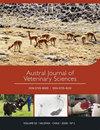Equine strangles: An update on disease control and prevention
IF 0.8
4区 农林科学
Q3 VETERINARY SCIENCES
引用次数: 5
Abstract
Streptococcus equi spp. equi (SEE) causes a disease in horses commonly referred to as strangles. Carrier or reservoir equids are important for the maintenance of the bacteria between epizootics and the initiation of outbreaks on premises, they also make the control and prevention of the disease more difficult. Disease outbreaks are common in many countries, affecting negatively equine health and causing major economic losses to the equine industry. This review describes general aspects of the disease caused by SEE in horses (clinical signs, pathogenesis, epidemiology, treatment, complications) and then focuses on prevention, control and eradication mechanisms.马勒死:疾病控制和预防的最新进展
马链球菌。马(SEE)引起马的一种疾病,通常被称为勒死。携带者或宿主马对于在流行病和场所爆发疫情之间维持细菌非常重要,它们也使疾病的控制和预防更加困难。疾病爆发在许多国家很常见,对马的健康产生负面影响,并给马业造成重大经济损失。这篇综述描述了SEE引起的马疾病的一般方面(临床症状、发病机制、流行病学、治疗、并发症),然后重点介绍了预防、控制和根除机制。
本文章由计算机程序翻译,如有差异,请以英文原文为准。
求助全文
约1分钟内获得全文
求助全文
来源期刊

Austral Journal of Veterinary Sciences
Veterinary-General Veterinary
CiteScore
1.60
自引率
0.00%
发文量
18
期刊介绍:
Austral Journal of Veterinary Sciences (formerly Archivos de Medicina Veterinaria) publishes original scientific contributions in English, containing the latest developments and discoveries in veterinary sciences. The journal covers topics such as animal health and production, preventive medicine, zoonosis, pharmacology and therapeutics, methods of diagnosis, and other areas related to the veterinary field.
Austral Journal of Veterinary Sciences aims to divulge information about advances in veterinary medicine among universities, research centres, industries, government agencies, biologists, agronomists and veterinarians.
 求助内容:
求助内容: 应助结果提醒方式:
应助结果提醒方式:


